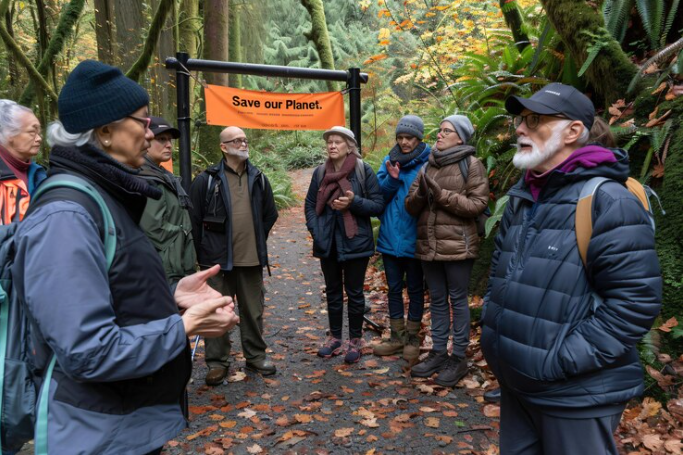Understanding the Environmental Benefits of Exercise
Describe how exercise can positively affect your environmental health. Exercise is commonly associated with enhancing physical and mental well-being, but its benefits extend far beyond individual health.
Regular physical activity can also have significant, positive effects on environmental health. This blog will delve into how exercise can positively affect your environmental health, supported by logical facts and interesting insights.
1. Reducing Carbon Footprint with Active Transportation

A straightforward way exercise benefits the environment is through the adoption of active transportation methods, such as walking, cycling, and running, instead of relying on motor vehicles. These eco-friendly modes of transportation help reduce carbon emissions and contribute to a healthier environment.
-
- Walking and Cycling: Opting for walking or cycling over short car trips can significantly reduce greenhouse gas emissions. For example, cycling just 10 km each way to work instead of driving can save approximately 1,500 kg of CO2 emissions annually. Walking and cycling also reduce traffic congestion and air pollution, making cities more livable.
-
- Public Transportation: Using public transportation often involves walking or cycling to and from transit stations. This not only decreases reliance on personal vehicles but also promotes physical activity, which further reduces carbon emissions.
2. Encouraging the Development and Preservation of Green Spaces

Regular exercise, particularly outdoors, creates a demand for green spaces such as parks, trails, and recreational areas. These green spaces are vital for environmental health as they improve air quality, support biodiversity, and provide natural habitats for wildlife.
-
- Urban Parks: Cities that prioritize the creation and maintenance of parks offer residents ample opportunities for outdoor exercise. These parks act as urban oases, reducing heat islands and absorbing CO2 while producing oxygen. The presence of urban parks can also enhance community well-being by providing a space for social interaction and physical activity.
-
- Community Trails: Developing trails and greenways encourages activities like hiking and biking. These pathways not only promote physical fitness but also connect people with nature, fostering a sense of environmental stewardship. Trails can also protect natural areas from urban sprawl and promote the conservation of ecosystems.
3. Sustainable Practices in Fitness Facilities

The fitness industry is increasingly embracing sustainability, with many gyms and fitness centers adopting eco-friendly practices that contribute to environmental health.
-
- Energy Efficiency: Modern gyms are investing in energy-efficient lighting, heating, and cooling systems. Some facilities even feature human-powered equipment that generates electricity as people exercise, turning physical activity into a renewable energy source.
-
- Waste Reduction: Gyms are reducing single-use plastics by offering water refill stations and encouraging the use of reusable bottles. Recycling programs and composting initiatives are also becoming more common. Additionally, fitness centers are implementing digital check-ins and paperless billing to minimize paper waste.
-
- Green Building Certifications: Fitness centers are seeking green building certifications such as LEED (Leadership in Energy and Environmental Design) to ensure their operations are environmentally responsible and resource-efficient. These certifications emphasize sustainable building practices, energy conservation, and water efficiency.
4. Promoting Environmental Awareness and Community Engagement

Exercise often involves community activities and events that can raise environmental awareness and promote sustainable living.
-
- Eco-Friendly Events: Many marathons, cycling races, and other fitness events are adopting sustainable practices, such as waste reduction, recycling, and using environmentally friendly materials. These events often encourage participants to use public transportation or carpool, reducing the overall carbon footprint.
-
- Community Clean-Ups: Exercise groups frequently organize clean-up events where participants pick up litter while running, walking, or biking. These activities improve the local environment and instill a sense of community and responsibility. Clean-up events also educate participants about the impact of litter on wildlife and ecosystems, fostering a greater appreciation for environmental conservation.
5. Enhancing Mental Health and Environmental Connection

Describe how exercise can positively affect your environmental health. Exercise has well-documented benefits for mental health, which can lead to a stronger connection with the environment. Individuals who engage in regular physical activity often experience reduced stress, anxiety, and depression, which can enhance their appreciation for nature. So, spending time in nature to reduce stress and anxiety is a valuable practice.
-
- Nature Therapy: Activities such as hiking, gardening, and outdoor yoga combine exercise with exposure to nature. This combination is known to improve mood, boost mental clarity, and increase overall well-being. Spending time in nature has been shown to reduce symptoms of ADHD in children, lower blood pressure, and improve sleep quality.
-
- Mindfulness and Conservation: Mindfulness practices like yoga and meditation often foster a deeper connection to the environment, leading to more eco-friendly behaviors and support for conservation efforts. Mindfulness can enhance one’s awareness of their surroundings, encouraging a more sustainable lifestyle and a commitment to protecting natural resources.
6. Reducing Reliance on Technology

Exercise can reduce reliance on technology, which has environmental benefits. By spending more time engaging in physical activities, individuals decrease their usage of electronic devices, reducing energy consumption and electronic waste.
-
- Outdoor Activities: Hiking, swimming, and other outdoor activities encourage people to disconnect from their devices and connect with nature, benefiting both personal health and the environment. These activities promote a healthy balance between screen time and physical activity, reducing the environmental impact of prolonged technology use.
-
- Digital Detox: Incorporating exercise into a digital detox routine helps individuals take breaks from screens, reducing energy consumption and the environmental impact of technology use. Regular physical activity can also improve posture and reduce the risk of eye strain associated with excessive screen time.
7. Encouraging Sustainable Lifestyle Choices

As the exercise promotes a holistic approach to physical therapy and mental health that often includes making sustainable lifestyle choices. To understand the science behind it, let’s describe how exercise can positively affect your environmental health.
-
- Healthy Diets: People who exercise regularly are more likely to adopt healthy eating habits, including choosing locally-sourced, organic, and plant-based foods. These choices have a lower environmental impact compared to processed and animal-based foods. Plant-based diets, in particular, reduce the demand for water-intensive animal farming and decrease greenhouse gas emissions.
-
- Minimalism: The discipline and mindfulness developed through regular exercise can inspire a minimalist lifestyle, reducing consumption, decluttering living spaces, and making more environmentally conscious choices. A minimalist approach can lead to less waste, reduced energy consumption, and a smaller ecological footprint.
8. Advocating for Clean Air

Regular outdoor exercise raises awareness about air quality and pollution issues, leading to advocacy for cleaner air and policies that reduce pollution.
-
- Air Quality Monitoring: Outdoor enthusiasts such as runners and cyclists often become more attuned to air quality. This awareness can drive demand for better air quality monitoring and pollution reduction policies. Improved air quality has numerous health benefits, including reduced respiratory problems and lower rates of cardiovascular disease.
-
- Community Advocacy: Communities that value outdoor exercise are more likely to advocate for clean air initiatives, including reducing vehicle emissions, supporting public transportation, and promoting green infrastructure. Advocacy efforts can lead to the implementation of policies that protect public health and preserve the environment.
9. Supporting Conservation Efforts and Eco-Tourism

Exercise can support conservation efforts and eco-tourism, both of which are crucial for preserving natural environments.
-
- Eco-Tourism: Activities like hiking, kayaking, and wildlife watching promote eco-tourism, emphasizing environmental sustainability, conservation, and support for local communities. Eco-tourism encourages responsible travel practices, such as minimizing waste, respecting wildlife habitats, and supporting local economies.
-
- Conservation Programs: Fitness and outdoor groups often partner with conservation organizations to protect natural habitats through trail maintenance, wildlife monitoring, and habitat restoration projects. These programs engage volunteers in meaningful activities that contribute to environmental preservation and biodiversity protection.
10. Creating a Positive Feedback Loop

The relationship between exercise and environmental health creates a positive feedback loop. As individuals become more engaged in physical activities, they develop a stronger connection to the environment, which in turn encourages more eco-friendly behaviors and advocacy.
-
- Increased Awareness: Regular exposure to nature through exercise increases awareness of environmental issues, fostering a sense of responsibility and urgency to protect natural resources. This heightened awareness can lead to more sustainable choices in everyday life, such as reducing single-use plastics and conserving water.
-
- Behavioral Changes: The benefits experienced from outdoor exercise can inspire individuals to adopt more sustainable practices in their daily lives, such as reducing waste, conserving energy, and supporting environmental initiatives. Positive experiences in nature can also motivate people to participate in environmental activism and community projects.
Conclusion
Exercise is not only beneficial for personal health but also plays a crucial role in enhancing environmental health. By choosing eco-friendly transportation, supporting green spaces, engaging in sustainable practices, and raising environmental awareness, individuals can positively impact the environment.
The interconnectedness of physical activity and environmental stewardship highlights the importance of a holistic approach to health and well-being. It becomes clear that embracing exercise as part of a sustainable lifestyle can lead to a healthier planet for future generations when we describe how exercise can positively affect your environmental health.
Incorporate these insights into your daily routine and share the benefits with your community. Together, we can create a healthier, more sustainable world through the power of exercise






